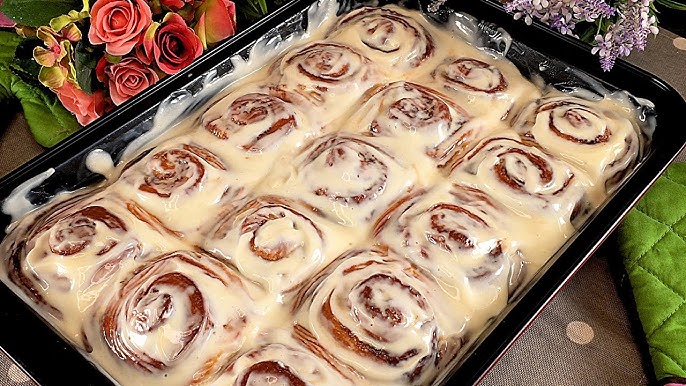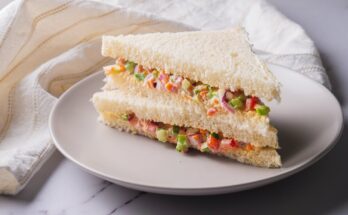Cinnamon Rolls Recipe: There’s nothing quite like the comforting aroma of cinnamon rolls baking in the oven. Whether it’s a holiday morning or just a cozy Sunday brunch, cinnamon rolls are a universal favorite. Their soft, pillowy texture combined with a sweet, cinnamon-spiced filling makes them a treat that’s hard to resist.
Making homemade cinnamon rolls might seem intimidating, but with this step-by-step guide, you’ll find it easier than you think. The beauty of making them from scratch lies not only in their unbeatable freshness but also in the joy of crafting something so delightful with your own hands. Let’s dive into the process, starting with everything you’ll need.
Ingredients You’ll Need
Here’s a detailed list of everything you need to whip up the perfect cinnamon rolls:
For the Dough:
- 4 cups (500g) all-purpose flour
- 2 ¼ tsp (1 packet) instant yeast
- ¼ cup (50g) granulated sugar
- 1 tsp salt
- ¾ cup (180ml) warm milk
- ¼ cup (60g) unsalted butter, melted
- 2 large eggs
For the Filling:
- ½ cup (100g) brown sugar
- 2 tbsp ground cinnamon
- ¼ cup (60g) unsalted butter, softened
For the Optional Glaze:
- 1 cup (120g) powdered sugar
- 2 tbsp milk
- ½ tsp vanilla extract
Feel free to adjust quantities based on the batch size you’re aiming for or personal preferences.
Tools and Equipment Required
Before you start, gather the following tools for a smoother experience:
Essential Tools:
- Large mixing bowl
- Rolling pin
- Measuring cups and spoons
- Spatula or spoon
Optional Tools:
- Stand mixer with a dough hook
- Pastry brush (for spreading butter)
- Serrated knife or dental floss (for slicing rolls)
Preparing the Dough
1. Activate the Yeast: Start by combining warm milk (not hot, around 110°F or 45°C) with sugar and yeast. Stir lightly and let it sit for 5-10 minutes until it becomes frothy. This step ensures your yeast is alive and ready to work.
2. Mix the Dough: In a large mixing bowl, combine the yeast mixture with melted butter, eggs, salt, and half the flour. Gradually add the remaining flour until the dough starts to pull away from the sides of the bowl. If you’re using a stand mixer, the dough hook attachment will make this step easier.
3. Knead the Dough: Turn the dough onto a floured surface and knead it for about 8-10 minutes until it becomes smooth and elastic. You can also knead using the mixer if preferred.
4. Let the Dough Rise: Place the kneaded dough in a greased bowl, cover it with a clean towel or plastic wrap, and let it rise for about 1-2 hours, or until it doubles in size.
Making the Cinnamon Filling
1. Combine Ingredients: In a small bowl, mix brown sugar and cinnamon together. Ensure there are no lumps for an even spread.
2. Spread Evenly: Once your dough is rolled out (we’ll get to that in the next section), spread softened butter evenly over the surface. Then, sprinkle the cinnamon-sugar mixture on top, ensuring it covers every corner for consistent flavor.
Assembling the Cinnamon Rolls
1. Rolling Out the Dough
Once your dough has doubled in size, gently punch it down to release any air bubbles. Transfer the dough to a floured surface and use a rolling pin to roll it out into a rectangle approximately 16×12 inches (40×30 cm). The thickness should be even to ensure uniform rolls.
2. Adding the Filling
After rolling out the dough, spread the softened butter evenly over the surface. Using a spatula or your hands, sprinkle the prepared cinnamon-sugar mixture generously across the dough. Be sure to cover the edges for a balanced taste in every bite.
3. Rolling and Slicing
Carefully roll the dough from the longer side into a tight log. Pinch the seam to seal it, ensuring it doesn’t unravel during baking. Use a serrated knife or dental floss to slice the log into 12 equal rolls. Aim for about 1 to 1.5-inch thickness per roll.
Place the slices in a greased or parchment-lined baking dish, leaving slight gaps for expansion during the second rise.
Second Rise of the Rolls
1. Why the Second Rise is Crucial
This step allows the dough to become light and fluffy. Skipping or rushing this rise may result in dense rolls, which is not what you want in a cinnamon roll.
2. Ensuring Optimal Proofing
Cover the baking dish with a clean kitchen towel or plastic wrap and let the rolls rise for 30-45 minutes. They should nearly double in size. A warm, draft-free area is ideal for this step. If it’s a cold day, you can place the rolls in a slightly warmed (but turned off) oven to help them rise.
Baking the Cinnamon Rolls
1. Preheating the Oven
Preheat your oven to 350°F (175°C) during the second rise. This ensures it’s at the right temperature when the rolls are ready to bake.
2. Proper Baking Techniques
Once the rolls have risen, bake them in the preheated oven for 20-25 minutes, or until they are golden brown on top. Keep an eye on them during the last few minutes to avoid overbaking. If the tops brown too quickly, you can loosely cover them with aluminum foil.
Remove the rolls from the oven and let them cool for 5-10 minutes before adding the glaze.
Making the Glaze
1. Simple Glaze Recipe
Combine powdered sugar, milk, and vanilla extract in a small bowl. Whisk until smooth. If you prefer a thicker glaze, add more powdered sugar; for a thinner glaze, add a touch more milk.
2. Adding a Unique Twist
To make your glaze stand out, consider adding:
- A splash of maple syrup for a rich, autumnal flavor
- Cream cheese for a tangy finish
- Orange zest for a refreshing citrus twist
Drizzle the glaze generously over the warm rolls and watch it melt into the crevices.
Serving Suggestions
1. Pairing with Beverages
Cinnamon rolls are best enjoyed warm with a hot cup of coffee, tea, or a glass of milk. For a luxurious treat, pair them with a latte or hot chocolate.
2. Storing Leftovers
If you have any leftovers (unlikely!), store them in an airtight container at room temperature for up to 2 days. For longer storage, refrigerate them for up to a week. Reheat in the microwave for 15-20 seconds to enjoy them as if they were fresh out of the oven.
Troubleshooting Common Issues
1. Rolls Not Rising Properly
- Check the yeast expiration date; inactive yeast won’t work.
- Ensure the milk isn’t too hot or too cold during activation.
2. Dough Texture Problems
- If the dough is sticky, add more flour (a tablespoon at a time).
- Over-kneading can make the dough tough, so knead just until smooth.
3. Overbaked or Underbaked Rolls
- Use an oven thermometer to ensure accurate temperature.
- Bake until the tops are golden, but avoid leaving them in too long.
Tips for Customizing Your Cinnamon Rolls
1. Adding Nuts, Fruits, or Chocolate
- Sprinkle chopped pecans, walnuts, or raisins over the cinnamon-sugar filling.
- Add chocolate chips for a decadent twist.
2. Different Flavor Variations
- Apple Cinnamon Rolls: Add diced apples to the filling.
- Pumpkin Spice Rolls: Mix pumpkin puree and spices into the dough.
- Cardamom Rolls: Replace cinnamon with ground cardamom for a Scandinavian touch.
Healthier Alternatives
1. Substituting Ingredients for a Lighter Version
- Use whole wheat flour or a mix of whole wheat and all-purpose flour.
- Substitute granulated sugar with coconut sugar or honey.
2. Vegan or Gluten-Free Options
- Replace milk with almond or oat milk, and use vegan butter.
- Opt for a gluten-free flour blend for a celiac-friendly recipe.
FAQs About Cinnamon Rolls Recipe
1. What ingredients are needed for cinnamon rolls?
To make cinnamon rolls, you’ll typically need flour, sugar, butter, yeast, milk, eggs, cinnamon, and brown sugar. Optional ingredients include vanilla extract and cream cheese for the icing.
2. How long does it take to make cinnamon rolls?
From start to finish, it takes about 2–3 hours to prepare and bake cinnamon rolls, including the time for the dough to rise.
3. Can I make cinnamon rolls ahead of time?
Yes, you can prepare the dough and fill the rolls, then refrigerate overnight. Bake them fresh in the morning for the best results.
4. What’s the best way to store cinnamon rolls?
Store cinnamon rolls in an airtight container at room temperature for up to 2 days or in the refrigerator for up to a week. Reheat before serving for a fresh taste.
5. Can I freeze cinnamon rolls?
Yes, you can freeze unbaked or baked cinnamon rolls. Wrap them tightly in plastic wrap or aluminum foil and store in a freezer-safe container for up to 3 months.
6. How do I make the icing for cinnamon rolls?
Classic cinnamon roll icing is made with powdered sugar, milk, butter, and vanilla extract. For a richer option, use cream cheese instead of butter.
7. What are common mistakes to avoid when making cinnamon rolls?
Avoid over-kneading the dough, skipping the dough’s rising time, or overfilling with cinnamon sugar to prevent the rolls from being tough or messy.
8. Can I make cinnamon rolls without yeast?
Yes, yeast-free cinnamon rolls are possible using baking powder as a leavening agent, though the texture will be more biscuit-like than soft and fluffy.
9. What variations can I try with cinnamon rolls?
Experiment with fillings like chocolate, fruit, or nuts. You can also try flavored icing, such as maple or caramel, for a unique twist.
Conclusion
There you have it—a foolproof, step-by-step guide to making the most delicious homemade cinnamon rolls. With their irresistible aroma, gooey center, and delectable glaze, these rolls are a guaranteed crowd-pleaser. Whether you’re a seasoned baker or trying them for the first time, this recipe is bound to impress.



